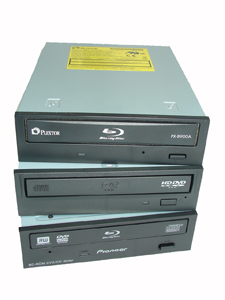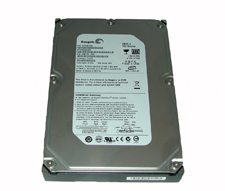Mass Storage
Finding the right video source for our High Definition tests was a little more difficult than we anticipated. We thought of several titles that would be perfect for generating stunning video playback sequences, but each title was available in either HD-DVD or Blu-ray formats only. In the end, we chose a couple of titles that offered very good visuals but more importantly were available in SD, HD-DVD, and Blu-ray formats. These two titles are Mission Impossible 3 and Swordfish. While we would love to show Halle Berry's special scene in Swordfish, we will instead focus on one of the colorful action scenes in the beginning of the movie. Mission Impossible 3 affords us a scene where Tom Cruise is scaling the wall at the Vatican, and that will separate the good from bad when it comes to moiré patterns in 1080P.
In order to display those movie sequences we need the latest HD software, so we naturally used
CyberLink's PowerDVD Ultra and
Corel's InterVideo WinDVD 8 Platinum HD/BD . Both programs gave us migraines under Vista up until the latest patches, and we are still a little on edge during scene switching and extended playback. Of course, this is almost standard fare with Vista, but we will cover these issues and others in a separate article. On a side note, we are also utilizing the
HD HQV Benchmark to evaluate the picture quality output of our graphics solutions and Intel's
Digital Home Capabilities Assessment 2.0 Tool to verify our platform's digital video capabilities and expected stability when playing back various video formats.
Having the software available for viewing and playback does little good if we do not have the proper optical drives that are up to the task. As an offshoot of this particular roundup we will start reviewing optical drives again at AnandTech in the near future. In the meantime, our HD capable test drives consisted of the
Plextor PX-B900A , Toshiba
SD-H802A , and Pioneer
BDC-S02BK . Our standard DVD playback drive is the
Lite-On LH-20A1P and we might even throw in a playback comparison between the Toshiba SD-H802A HD-DVD drive and the Microsoft
Xbox 360 HD DVD Player. Unfortunately, we were hoping to receive the
Toshiba SD-H903A HD-DVD writer to compare directly to the new low cost Pioneer BDC-S02BK Blu-ray writer but our sample has been delayed. However, we should receive it in time for the optical drive reviews.
While we are on the subject of storage, it turned out one of the most difficult choices we had to make was choosing what hard drive to utilize. In keeping with our silent and inexpensive theme we settled on the Samsung
SpinPoint T166 500GB for our standard test bed. That said, we wanted to try something a little different for our featured HTPC buildup and selected the
Seagate DB35.3 750GB hard drive that is designed for DVR-specific challenges such as power consumption, video streaming performance, acoustics, and long term reliability. For those that like to throw caution to the wind, we also will be testing two of the Seagate DB35.3 500GB drives in RAID 0 and RAID 1 to see how well they perform against our standard Samsung T166 500GB in video specific testing. As if that's not enough, we also have the
Seagate SV35.2 500GB drive engineered specifically for use in digital video surveillance systems. Not to be left out, Western Digital is trying their hardest to get us production level
GreenPower hard drives for our home office platform buildup and Hitachi has promised a
CinemaStar 7K1000 for our HTPC buildup.
(Ed: Did we mention the Feature Creep yet?)














42 Comments
View All Comments
larson0699 - Wednesday, August 8, 2007 - link
If speaking on OEM machines, then by all means, touché. I would imagine that most of the AT/DT audience are builders, however, which gives us the choice NOT to install an OS that feels like Norton all over again.. Gamers especially feel this.
Anywho, for a lot of us Vista is NOT the future, and until more is known of '7', we may well stay with 2K/XP for a loooooong time.
At least you use Linux in your tests as well, but again.. SUSE??
Myrandex - Friday, August 10, 2007 - link
No reason for the hate towards SuSE. That is my fav. distro by far!TA152H - Tuesday, August 7, 2007 - link
I'm not sure how Micro-ATX is automatically low cost. Considering how well SFF computers sell, and how poorly full sized computers do by comparison, I think the main reason (OK, you're about to think "duh") is the size! But, yet, you've made it low cost and low power. Size matters!But, really, I think it's interesting you're going with quiet and low power, but I also think you could make a point for higher cost machines as well. Really, the smaller motherboard should be faster, not slower, since the memory is closer to the controller. Granted, you can't use as many expansion cards, but who uses two video cards anyway? The motherboards come with so many features, there really is not that you can not put in a Micro-ATX. A better video card, a better sound card. Could be high end depending upon the choices, and the choice of processors and memory, right? So, I think you'll have some performance freaks getting this factor too, it's so nice to have a small computer instead of some desk hog. And under desk sucks because you can't see the lights, which still give useful information. And, of course, it's easier to put in CDs and DVDs if it's on your desk, instead of under.
Also, much more interesting to me, although probably not to the readers here, are mini-ITX based machines, particularly the ultra low power ones from Centaur/VIA. These things are great in the summer, and now have some really interesting parts (mine is a year old, and kind of slow). How about 1.2 GHz at 3.5 watts max power? It's a slow 1.2 GHz, but still, it's a great surfing/email, etc... machine. Admittedly, it's not the main focus of this site, but it's still a very, very, very useful machine, and much better than the mainstream Intel/AMD solutions for a large subset of people. Except in the winter in the cold regions, I guess. It might be interesting for you guys to review too. From personal experience, using this machine instead of my older surfer (and underclocked Celeron 1100/100 running at 733/66 and AIW 9000) keeps my bedroom so much cooler in the summer, it's terrific. It's a bit slow though at 800 MHz, but the new ones use considerably less power, and are 50% faster! I bet a lot of people would be interested in this type of article.
hardwareguy - Tuesday, August 7, 2007 - link
What's with the expensive/unknown speaker choice? It seems there are very few places in the USA that sell these speakers and they are pretty pricey. There are also a few reviews of the ($200) M200s on Newegg where the reviewers were unable to contact the Swans to replace a defective product.I wasn't even able to find acculine's website, just the audio insider's product page. I would definitely not feel comfortable spending that kind of money on a company that I can't even find contact info for. Perhaps you should stick to some less eccentric product choices in the future.
Pirks - Tuesday, August 7, 2007 - link
From the article:"Unfortunately, we were hoping to receive the Toshiba SD-H903A HD-DVD writer to compare directly to the new low cost Pioneer BDC-S02BK Blu-ray writer but our sample has been delayed."
Pioneer BDC-S02BK is NOT a Blu-ray writer. It is a DVD writer that can READ Blu-ray discs. It can NOT write to them. Please fix the article.
yyrkoon - Tuesday, August 7, 2007 - link
I am not sure it makes sense to test the ABIT NF-M2 nView. I have been going on from time to time about it, I own it, and I really like the board, but ABIT discontinued it sometime ago. I personally would like to see your results, but owning one, I already know where it stands stability wise (second to none ring a bell ?).Anyhow, it is probably too late, but perhaps one of the replacements would be better suited ? Granted, the replacements all seem to have slightly less features, and I have no idea how stable they are . . .
8steve8 - Tuesday, August 7, 2007 - link
we are curious about onboard video performance, what about system performance(non-games) while using onboard video... does it suffer?(since memory and memory bandwidth is shared)
please please dont bother talking about same-chipset performance differences of boards if its close...
the last thing anyone wants anymore is 20 pages of gamming benchmarks comparing 15 boards all using the same chipsets... we all know the performance is basically identical,, the only thing we are concerned between boards of the same chipset is reliability/stability , maybe overclocking and features.. like does it have DHCP-DVI. or like does it use a cheap via firewire chip, or a nice Ti firewire chip... what about networking controller.. is it pci or pcie...onboard sound quality? optical output?..
raid... just 1/0 or does it do raid 5...
what about data corruption... some earlier nforce chipsets and earlier via chipsets caused data corruption with cirtain drivers...remember early via chipsets not properly implimenting pci to intel's spec.. so lots of pci cards had issues, including sound and raid controllers which back then ran on pci.... that is devistating... i have an old nforce4 ultra AMD board which consistantly corrupts data on harddrives...i would gladly take 10% less performance if i know the board will operate properly.
the problem is these issues dont really become well known until months after the product is out... long after we bought it...
i belive i can trust intel southbridges, and i think the new nvidia 430 and newer sata controllers are trustable, but can this can be confirmed?
do all new boards have solid state capacitors? will they? should they?
the intel board probably looks the best of the bunch... the g33TL
has DHCP-DVI with onboard video capable of warcraft3@1600x1200@30fps (i know cause my g965 can)
has Intel Gigabit networking
has an ich9r southbridge w/6sata.
has a bios which properly does sleep/standby etc... ?
has audio with optical output.
people might say intel boards are picky with ram... but thats cause they buy crappy ram... like corsair and kingston hyperX .. DDR2-800 as defined by jedec uses 1.8V... crappy ram requires more to opperate... and if u look at the "gamer" ram.. it all needs like 2.1 volts.. its utter crap... thast why intel boards dont work with that ram.
ive never heard of an issue with intel boards and ram that meets jedec spec...
but of course they cant overclock... so thats a big downer for some.. (but definately not all)
some in the industry are calling for mainstream adoption of ECC memory.
some things of note... you can use unbuffered ecc ram with an amd system / server on the cheap..
athlon x2's memory controller has suppored ecc for a long time... maybe since the origional x86-64 cpu.
you cannot do that with mainstream intel chipsets.... i dont think u can do it with any intel uatx board.
but the x38 and 975x might do ecc, im not sure.
nsparadox - Tuesday, August 7, 2007 - link
I understand that you're excited to cover a lot of material. Keep in mind that many of your readers will, in the end, scan maybe the first paragraph of the introduction, check out their favorite benchmarks or concerns (noise, heat, etc)., and then move straight to the conclusion.Rather than scientifically test every single aspect of a "platform", maybe it's best to play with some of these concepts and make a few generalizations based on your experience. That should leave you with ample time and focus to hone in on the issues that you think users care about the most.
Or, focus on a single platform and do your broad but shallow scan (choose between building the best HTPC, LAN box for gaming, quiet computer for gaming, quiet computer for productivity, but don't do all of them). Go ahead and write multiple articles. I think there's plenty you can write about each platform, especially if you focus on price/performance tradeoffs.
The beauty of the DIY desktop PC is that everything is componentized. Take advantage of it with your reviews!
Frumious1 - Tuesday, August 7, 2007 - link
When readers skip a lot of the material, that's their own choice. I certainly wouldn't want to purchase a motherboard without a decent amount of information on how well the BIOS and other features work - especially if I'm looking at a uATX board with IGP. Let Gary get all the articles done and then see how it all comes together. I'm not sure how he's going to cover all the additional content, but I won't judge until it's out there. :)mostlyprudent - Tuesday, August 7, 2007 - link
I find myself skimming and skipping when there is a drawn out series of reviews that are essentially the same (i.e. the cooler and now the PSU reviews here). Once I read the methodology article for the PSU reviews, I read the first review or two in its entirety, but now I skim the first page or tow, check the benchmark graphs/tables and read the conclusion.After reading this article, I get the impression that we are not simply going to get a string of motherboard reviews, but a series of unique articels that examine groups of MBs by chipset and other aspects of the HTPC system (cases, storage, displays, etc.). If that's the case, I personally will enjoy a full detailed read of each article